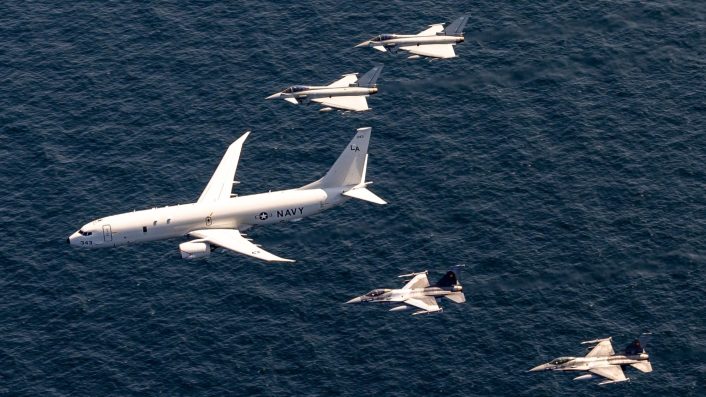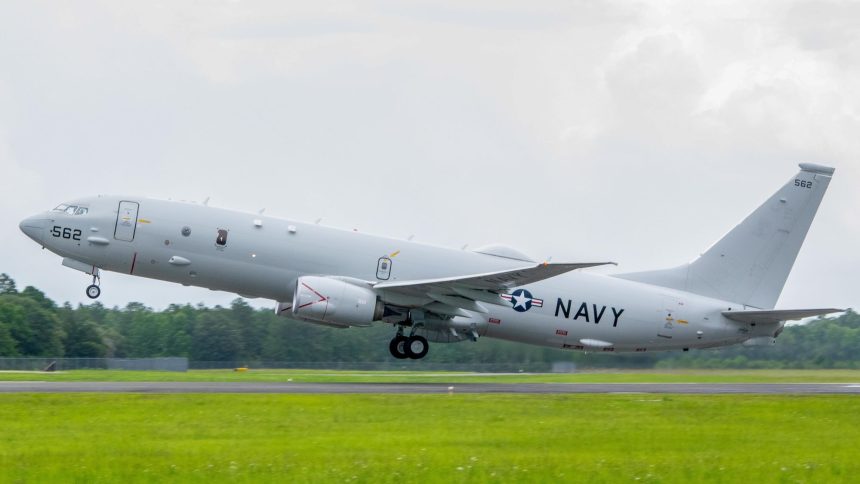The upgrade brings the full set of capabilities outlined in the P-8A program’s evolutionary acquisition strategy.
The U.S. Navy’s Naval Air Systems Command (NAVAIR) announced last week the completion of the Increment 3 Block 2 (I3B2) modifications on the first P-8A Poseidon Maritime Patrol Anti-Submarine Warfare aircraft. The extensive upgrades brings the platform to the fullest extent of its envisaged capability as a full-spectrum ISR, sensing, submarine-hunting and surface-strike aircraft, preserving its relevance through the 2030s.
The new modified P-8A is one of the seven airframes chosen for the upgrades in the contract with Boeing. The first aircraft is expected to be delivered to the Navy this month. I3B2 now brings the “full ASW, anti-surface warfare (ASuW), and intelligence, surveillance and reconnaissance (ISR) capabilities outlined in the P-8A program’s evolutionary acquisition strategy,” explains NAVAIR.
The picture released by NAVAIR showed a P-8A Poseidon with the BuNo 169562, with the caption saying the aircraft was taking off with the I3B2 upgrades in Jun. 2025, suggesting this was the first aircraft that underwent the overhaul.
View this post on Instagram
NAVAIR also released a video on its Instagram profile showing a few P-8A Poseidons taxing and taking off, mentioning that the I3B2 program upgrades the airframe and avionics with “enhanced sensors, digital interoperability and expanded weapons capacity.” Among the aircraft shown, a longer part of the video shows the P-8A 169562, the first to be modified.
The U.S. Navy currently operates 124 P-8A Poseidons, and plans to upgrade its entire planned fleet of 135 P-8As. Australia’s 14 Poseidons will also receive the upgrades.
Besides the U.S and Australia, the Poseidon is also flown by Germany, U.K., India, South Korea, Norway, New Zealand and, in future, Canada. A total of 185 P-8s are flying today, collectively counting over 660,000 flight hours.
The first Increment 3 Block 2 modification for the P-8A Poseidon to the @USNavy recently ferried off from Cecil Airport in Jacksonville, Florida.
This significant #P8 upgrade includes a new combat systems suite that will enhance the sub hunter’s search, detection, & targeting… pic.twitter.com/sUIEDSNF4n
— Boeing Defense (@BoeingDefense) June 18, 2025
Increment 3 Block 2 upgrades
The P-8 fleet is overseen by the Maritime Patrol and Reconnaissance Aircraft Program Office (PMA-290), while the work on the first airframe commenced at Boeing’s Maintenance, Repair and Overhaul hangar at Cecil Hangar in Jacksonville Florida in Mar. 2024.
The aircraft has been described as the Navy’s “premier multi-mission aircraft and cornerstone of the Maritime Patrol and Reconnaissance Force (MPRF).”
The Increment 3 Block 2 upgrade to the airframe and avionics systems “includes new airframe racks, radome, antennas, sensors, and wiring.” The electronics comprise “a new combat systems suite with improved computer processing, higher security architecture, a wide band satellite communication system, an ASW signals intelligence capability, a track management system, and additional communications and acoustics systems to enhance search, detection and targeting capabilities.”

According to AIN, a new secure communications suite also allows the P-8A to coordinate effectively with ships of a carrier battle group, while enhancing interoperability with allied navies. New ASW capability includes “signals intelligence and an enhanced multistatic active coherent sonar system that tracks detonation sounds reflected off submarines and detected by receiver buoys,” AIN added. A new track management system meanwhile fuses and prioritizes data on a single, aided by better “computing power” to meet the new demands of the improved mission suite.
As reported by The Aviationist in Aug. 2024, when a new Multi-Mission Pod (MMP) developed by Boeing was spotted on a Navy P-8A Poseidon, I3B2 allows the “aircrews to search, locate and track the most advanced submarines in the world, enabling the fleet to pace the threat with the required capability and capacity to win the fight.”
For surface strike missions, the P-8A Poseidon can already carry four AGM-84 Harpoons under its four underwing hardpoints, and is also being tested to be integrated with the AGM-184C LRASM (Long-Range Anti-Ship Missile) by Boeing and the U.S. Navy, with the company saying the work was scheduled to be concluded by the summer of 2024.

ASW upgrades
Military Aerospace Electronics reported on Jun. 18, 2025, that NAVAIR Patuxent River, Maryland, awarded a $12.9 million contract to RTX BBN Technologies Inc. to upgrade and modify the Ground Replay System (GRS) used with the P-8A.
The GRS is a high-fidelity acoustic mission reconstruction of sorties from the P-8A anti-submarine warfare (ASW) aircraft that enables Navy ASW efforts to stay updated with P-8A acoustic capabilities. “RTX BBN experts will ensure that the GRS software algorithms and displays remain in alignment with Navy ASW systems, and remain backwards-compatible with previous P-8A aircraft versions,” the report said.
RTX BBN will also update the P-8A Poseidon’s ASW systems up to date with new multistatic active coherent (MAC) enhancements, and multiple input multiple output (MIMO) capabilities of the new AN/SSQ-101C and the AN/SSQ-125B sonobuoys. Other systems to be handled by the company include undersea advantage (USA) receiver sonobuoy array modifications; next-generation MAC-E active and passive sonobuoy signal processing; new operator machine interface designs; and high-duty-cycle capabilities.
#USNavy Sailors conduct an anti-submarine warfare exercise in a #USNavy P-8A Poseidon aircraft while out of Sigonella, Italy. VP-46 is currently forward-deployed to @USNavyEurope and conducts maritime patrol and reconnaissance missions throughout Europe and Africa. #FlyNavy pic.twitter.com/hJq7TeRqb6
— U.S. Navy (@USNavy) February 10, 2021
Future
Building upon the experience gained from the I3B2 upgrades, “future P-8A modifications will be made via a sequence of rapid capability insertion efforts,” NAVAIR added. The NAVAIR release quoted PMA-290 program manager, Capt. Erik Thomas, who upheld “lethality and survivability” for “today’s ever changing global environment.”
The P-8A Poseidon aircraft is a proven capability, conducting tasks including anti-submarine warfare & search & rescue missions. We’re acquiring two additional Poseidon aircraft bringing the fleet to 14 as part of the Govt’s $270 bn investment in defence capability over 10 years. pic.twitter.com/VP9uyRFvGP
— Linda Reynolds (@lindareynoldswa) December 29, 2020
“The Increment 3 Block 2 modifications to the P-8A Poseidon will ensure they remain the most sophisticated and capable maritime patrol and reconnaissance aircraft in the world,” said Capt. Thomas. NAVAIR described the P-8A the Department of Defense’s “only long-range full-spectrum ASW, cue-to-kill platform, with substantial armed ASuW and networked ISR capabilities.”









